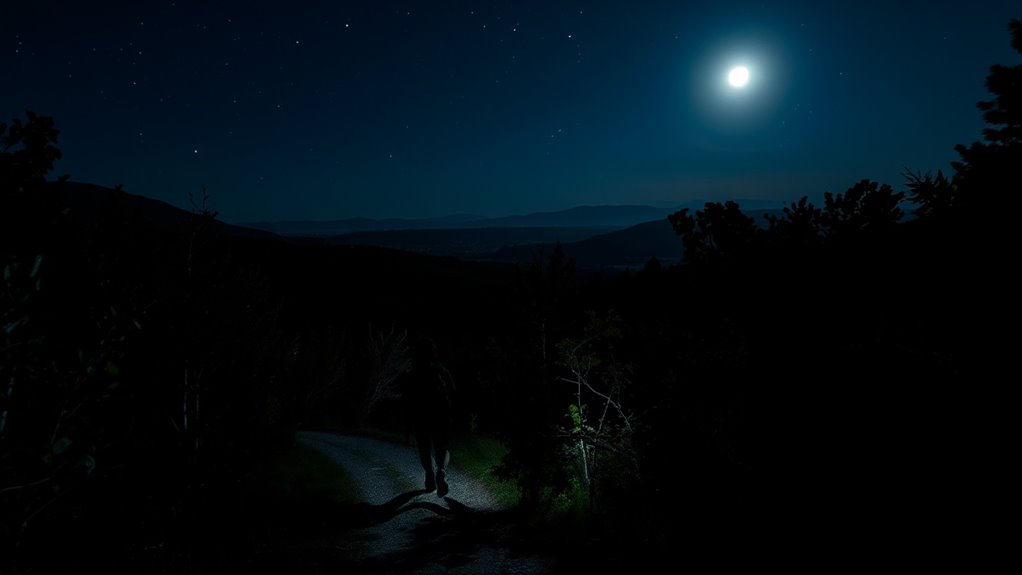During moonlit journeys, you can navigate by recognizing key constellations like Polaris and the Big Dipper in the Northern Hemisphere or the Southern Cross in the Southern Hemisphere. Find Polaris by tracing an imaginary line through the outer stars of the Big Dipper, which points north. In the south, extend the Southern Cross’s long axis to locate the south celestial pole. Keep practicing these techniques to develop confidence—more tips await if you keep exploring.
Key Takeaways
- Use Polaris as a reliable northern anchor by drawing an imaginary line through the Big Dipper’s outer stars.
- In the Southern Hemisphere, locate the Southern Cross and extend its long axis to find the south celestial pole.
- Recognize key constellations like the Little Dipper or Southern Cross to confirm directions quickly.
- Practice identifying star patterns and their seasonal positions to improve navigation accuracy.
- Carry star charts or navigation apps, and use natural star cues over electronic devices for dependable night navigation.

Ever wondered how to find your way in the dark when visibility is limited? When the moonlight isn’t enough to illuminate your path, you need reliable methods to navigate safely. One of the most effective techniques is understanding star patterns and using celestial navigation. It might sound complex at first, but with a little practice, you can harness the night sky to guide you through unfamiliar terrain. The key lies in recognizing specific constellations and knowing how to interpret their positions relative to your location.
Start by familiarizing yourself with the prominent star patterns visible in your hemisphere. For example, in the Northern Hemisphere, the North Star, Polaris, is your primary reference point. It’s part of the Little Dipper constellation and sits almost directly above the North Pole. Finding Polaris is straightforward if you locate the Big Dipper’s two outer stars and draw an imaginary line through them; this line points directly to Polaris. Once you’ve identified Polaris, you can determine your north direction with confidence, which is vital for maintaining your bearings during a moonlit journey. In the Southern Hemisphere, you might rely on the Southern Cross constellation. By locating the cross and extending its longer axis, you can find the south celestial pole, giving you a solid sense of direction.
Identify Polaris in the Big Dipper to find north; extend the Southern Cross for south.
Celestial navigation becomes more precise as you understand the movement of stars across the sky. Stars appear to rotate around the celestial poles, and their positions change with the seasons. You can use this to your advantage by noting the positions of specific stars at a given time of night and comparing them to star charts or navigation apps. This method is especially valuable when landmarks are sparse, and the terrain offers no clear visual cues. With a basic understanding of star patterns, you can keep track of your heading and avoid getting lost, even in the darkest conditions. Additionally, understanding the importance of celestial navigation can boost your confidence in relying on natural cues rather than electronic devices.
To put this into practice, always carry a star chart or a navigation app on your device. Practice identifying key constellations and Polaris during the day or when the sky is clear. With regular practice, recognizing star patterns becomes second nature, allowing you to use celestial navigation seamlessly during moonlit journeys. Remember, the more familiar you are with the sky’s layout, the more confident you’ll feel relying on these ancient yet effective techniques. Night navigation isn’t just about survival; it’s about connecting with the natural world and using its signals to guide you safely through the dark, uncharted hours.
Frequently Asked Questions
How Do Animals Navigate During Moonlit Nights?
During moonlit nights, animals rely on their animal senses and nocturnal strategies to navigate effectively. You might notice that many creatures, like bats and owls, use echolocation or keen hearing to find their way, even when visibility is low. Their heightened senses help them detect subtle cues, such as the scent of water or the position of stars, enabling smooth travel through the darkness without needing moonlight for guidance.
What Are the Best Clothing Choices for Night Navigation?
When maneuvering at night, choose clothing that keeps you warm and visible. Opt for thermal clothing options to stay cozy in cooler temperatures. Incorporate glow in the dark garments, like reflective jackets or accessories, to enhance visibility without sacrificing comfort. Layer appropriately, combining thermal base layers with moisture-wicking and windproof outerwear. This way, you’ll stay warm, visible, and prepared for any challenges during your moonlit journey.
Can Stars Be Used for Precise Navigation?
Stars can be used for precise navigation by understanding celestial coordinate systems and interpreting star charts. You can identify Polaris, the North Star, to find true north, especially in the northern hemisphere. By recognizing key constellations and using star charts, you can determine your position and direction accurately. Mastering star chart interpretation helps you navigate confidently, even when the sky is your only guide at night.
How Does Moon Phase Affect Navigation Accuracy?
The moon phase considerably impacts your navigation accuracy by affecting moonlight visibility. During a full moon, the lunar cycle impact provides ample illumination, making it easier to see landmarks and navigate confidently. Conversely, in a new moon phase, limited moonlight hampers visibility, increasing reliance on other navigation methods. Understanding the lunar cycle helps you plan your journey better, ensuring safer travel during varying moon phases.
What Are Common Night Navigation Mistakes to Avoid?
When traversing at night, avoid relying solely on your eyes, especially if there’s light pollution, which can distort your perception. Don’t forget that GPS reliability can decrease in areas with dense trees or tall buildings. Always carry backup tools like a compass and maps, and double-check your position regularly. Staying aware of these common mistakes helps guarantee your journey remains safe and accurate, even under challenging night conditions.
Conclusion
By mastering these night-navigation hacks, you’ll navigate confidently under moonlit skies. Remember, nearly 70% of outdoor enthusiasts have relied on natural cues like stars and terrain during nighttime adventures. With practice, you’ll become more intuitive and self-reliant in darkness. So, next time you set out after sunset, trust these tips, stay alert, and enjoy the quiet beauty of your moonlit journey. Your night adventures just got a whole lot safer and more exciting!










